Resources - Books
Finis Vitae
|
|
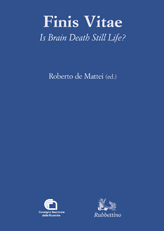 |
Finis Vitae
|
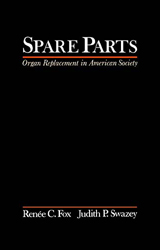 |
Spare PartsThe following content was provided by the publisher.The developments that have occurred in the field of organ transplantation during the 1980s and early 1990s, and the simultaneous rise and fall of the Jarvik-7 artificial heart are the subject of this vividly written and absorbing new volume. In Spare Parts, fascinating, interconnected stories< br> of organ transplantation and the artificial heart are recounted in an interpretive framework that explores the vision of the "replaceable body." Themes of uncertainty, gift exchange, and the allocation of scarce material and non-material resources underscore a discussion that openly examines the< br> escalating ardor about the goodness of repairing and remaking people with transplanted organs. Likewise, the stories open questions of life and death, identity, and solidarity. This important book offers insights into the symbolic and anthropomorphic meanings associated with the human body and its< br> organs, and into the ways that medical professionals come to terms with the concomitant aspects of transferring vital body parts. Both artificial and donor organs, as well as the process of transplantation, are the subject of a thoughtful discussion which touches on the medical myths and rituals< br> that they generate. Chronologically, Spare Parts begins where the authors' previous book, The Courage to Fail, leaves off. More than a sequel, however, this work reflects their increasingly troubled and critical reactions to the expansion of organ replacement. Likely to be controversial, this< br> book is must reading for bioethicists, medical sociologists and anthropologists, health-care lawyers, planners and administrators, nurses and physicians, medical journalists and sciencewriters, and concerned lay readers. Renee C. Fox, Judith P. Swazey, New York , Oxford University Press, 1992 , ISBN 0-19-507650-8 |
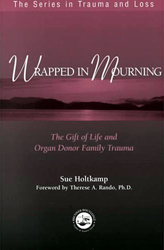 |
Wrapped in MourningThe following content was provided by the publisher.When organ transplantation is discussed, the focus is overwhelmingly placed on the life saving aspect of the operation. However, organ transplantation "is never just about life; it is also about death." The vast majority of transplanted organs come from individuals who have been declared, by legal and medical definitions, to be brain dead. Loved ones of these newly deceased are faced with unique problems and choices. Based on 15 years of experience working with organ procurement organizations and donor families, Wrapped in Mourning addresses the heretofore unexplored subject of organ donor family trauma. This book covers the issues surrounding organ donation, including the history of organ transplantation, how organs are procured for transplantation, as well as the medical procedure itself. Each issue is explored with regards to its impact upon donor families. Ways to reduce grief, prevent problems, and increase the benefits of donating organs for the donating family are discussed. Holtkamp demonstrates a rich understanding of donor family trauma, and Wrapped in Mourning is peppered with case studies and real-life scenarios that shed light on both sides of the "life-giving, death-ridden phenomenon of organ donation." Purchase |
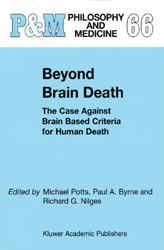 |
Beyond Brain DeathBeyond Brain Death offers a provocative challenge to one of the most widely accepted conclusions of contemporary bioethics: the position that brain death marks the death of the human person. Eleven chapters by physicians, philosophers, and theologians present the case against brain-based criteria for human death. Each author believes that this position calls into question the moral acceptability of the transplantation of unpaired vital organs from brain-dead patients who have continuing function of the circulatory system. One strength of the book is its international approach to the question: contributors are from the United States, the United Kingdom, Liechtenstein, and Japan. This book will appeal to a wide audience, including physicians and other health care professionals, philosophers, theologians, medical sociologists, and social workers.Edited by Michael Potts, Paul A Byrne an Richard G. Nilges, Klluwer Acdemic Publishers, P.O. Box 17, 3300 AA Dordrecht, The Netherlands, 2000 , ISBN 1-4020-03668-8 Purchase |
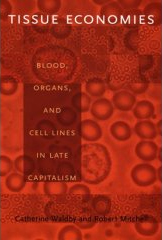 |
Tissue Economies Blood, Organs, and Cell Lines In Late CapitalismAs new medical technologies are developed, more and more human tissues-such as skin, bones, heart valves, embryos, and stem cell lines-are stored and distributed for therapeutic and research purposes. The accelerating circulation of human tissue fragments raises profound social and ethical concerns related to who donates or sells bodily tissue, who receives it, and who profits-or does not-from the transaction. Catherine Waldby and Robert Mitchell survey the rapidly expanding economies of exchange in human tissue, explaining the complex questions raised and suggesting likely developments. Comparing contemporary tissue economies in the United Kingdom and United States, they explore and complicate the distinction that has dominated practice and policy for several decades: the distinction between tissue as a gift to be exchanged in a transaction separate from the commercial market and tissue as a commodity to be traded for profit. |
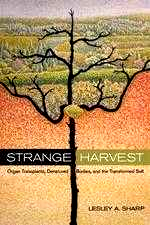 |
Strange Harvest Organ Transplants, Denatured Bodies, and the Transformed SelfStrange Harvest illuminates the wondrous yet disquieting medical realm of organ transplantation by drawing on the voices of those most deeply involved: transplant recipients, clinical specialists, and the surviving kin of deceased organ donors. In this rich and deeply engaging ethnographic study, anthropologist Lesley Sharp explores how these parties think about death, loss, and mourning, especially in light of medical taboos surrounding donor anonymity. As Sharp argues, new forms of embodied intimacy arise in response, and the riveting insights gleaned from her interviews, observations, and descriptions of donor memorials and other transplant events expose how patients and donor families make sense of the transfer of body parts from the dead to the living. For instance, all must grapple with complex yet contradictory clinical assertions of death as easily detectable and absolute; nevertheless, transplants are regularly celebrated as forms of rebirth, and donors as living on in others' bodies. New forms of sociality arise, too: recipients and donors' relatives may defy sanctions against communication, and through personal encounters strangers are transformed into kin. Sharp also considers current experimental research efforts to develop alternative sources for human parts, with prototypes ranging from genetically altered animals to sophisticated mechanical devices. These future trajectories generate intriguing responses among both scientists and transplant recipients as they consider how such alternatives might reshape established--yet unusual--forms of embodied intimacy.Lesley A. Sharp, University of California Press, Berkeley and Los Angeles , California , 2006 , ISBN 13 - 978 - 0 - 520 - 24786 - 4 Purchase |
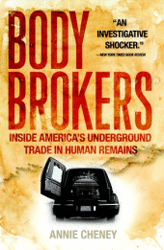 |
Body Brokers: Inside America's Underground Trade in Human RemainsExpanding on an award-winning article previously published in Harper?s Magazine, journalist Annie Cheney dissects the network of unscrupulous entrepreneurs who, quite without permission, remove various body parts from cadavers and sell them to interested parties. Unless chance reveals the crime, most grieving relatives have no idea that portions of their loved ones? corpses have been purchased for use in commercial medical research, surgical equipment, or military land-mine testing. Readers who have never given thought to what happens after a body?s consignment to a morgue or funeral home will find Cheney?s research both compelling and grotesque. |
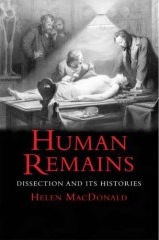 |
Human Remains Dissection And Its HistoriesUntil 1832, when an Act of Parliament began to regulate the use of bodies for anatomy in Britain, public dissection was regularly-and legally-carried out on the bodies of murderers, and a shortage of cadavers gave rise to the infamous murders committed by Burke and Hare to supply dissection subjects to Dr. Robert Knox, the anatomist. This book tells the scandalous story of how medical men obtained the corpses upon which they worked before the use of human remains was regulated. Helen MacDonald looks particularly at the activities of British surgeons in nineteenth-century Van Diemen's Land, a penal colony in which a ready supply of bodies was available. Not only convicted murderers, but also Aborigines and the unfortunate poor who died in hospitals were routinely turned over to the surgeons. This sensitive but searing account shows how abuses happen even within the conventions adopted by civilized societies. It reveals how, from Burke and Hare to today's televised dissections by German anatomist Dr. Gunther von Hagens, some people's bodies become other people's entertainment. |
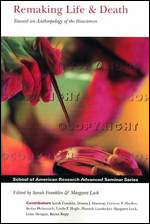 |
Remaking Life & Death: Toward an Anthropology of the BiosciencesTen contributions from biological and medical anthropologists consider the social implications of recent advances in biotechnology. A sampling of topics includes the commodification of the organs of brain dead patients; the reactions of various governments to cloning technologies; and the medical experiences of persons with genetic illnesses. The papers were originally presented at a seminar held at the School of American Research in Santa Fe in May 2000. Annotation ©2004 Book News, Inc., Portland, OR |
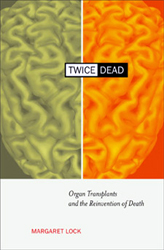 |
Twice Dead: Organ Transplants and the Reinvention of DeathTales about organ transplants appear in mythology and folk stories, and surface in documents from medieval times, but only during the past twenty years has medical knowledge and technology been sufficiently advanced for surgeons to perform thousands of transplants each year. In the majority of cases individuals diagnosed as "brain dead" are the source of the organs without which transplants could not take place. In this compelling and provocative examination, Margaret Lock traces the discourse over the past thirty years that contributed to the locating of a new criterion of death in the brain, and its routinization in clinical practice in North America. She compares this situation with that in Japan where, despite the availability of the necessary technology and expertise, brain death was legally recognized only in 1997, and then under limited and contested circumstances. Twice Dead explores the cultural, historical, political, and clinical reasons for the ready acceptance of the new criterion of death in North America and its rejection, until recently, in Japan, with the result that organ transplantation has been severely restricted in that country. This incisive and timely discussion demonstrates that death is not self-evident, that the space between life and death is historically and culturally constructed, fluid, multiple, and open to dispute. |
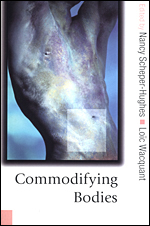 |
Commodifying BodiesIncreasingly the body is a possession that does not belong to us. It is bought and sold, bartered and stolen, marketed wholesale or in parts. The professions - especially reproductive medicine, transplant surgery, and bioethics but also journalism and other cultural specialists - have been pliant partners in this accelerating commodification of live and dead human organisms. Under the guise of healing or research, they have contributed to a new 'ethic of parts' for which the divisible body is severed from the self, torn from the social fabric, and thrust into commercial transactions -- as organs, secretions, reproductive capacities, and tissues -- responding to the dictates of an incipiently global marketplace. Breaking with established approaches which prioritize the body as 'text', the chapters in this book examine not only images of the body-turned-merchandise but actually existing organisms considered at once as material entities, semi-magical tokens, symbolic vectors and founts of lived experience. The topics covered range from the cultural disposal and media treatment of corpses, the biopolitics of cells, sperm banks and eugenics, to the international trafficking of kidneys, the development of 'transplant tourism', to the idioms of corporeal exploitation among prizefighters as a limiting case of fleshly commodity. This insightful and arresting volume combines perspectives from anthropology, law, medicine, and sociology to offer compelling analyses of the concrete ways in which the body is made into a commodity and how its marketization in turn remakes social relations and cultural meanings. |
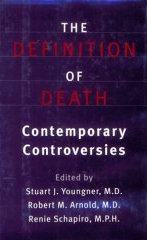 |
The Definition of Death: Contemporary ControversiesThe Definition of Death: Contemporary Controversies is the first comprehensive review of the clinical, philosophical, and public policy implications of our effort to redefine the change in status from living person to corpse. It is the result of a collaboration among internationally recognized scholars from the fields of medicine, philosophy, social science, law, and religious studies. Throughout, the contributors struggle to reconcile inconsistencies and gaps in our traditional understanding of death and to respond to the public's concern that, in the determination of death under current policies, patients' interests may be compromised by the demand for organ retrieval. |
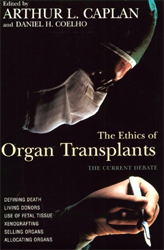 |
The Ethics of Organ Transplants: The Current DebateRenowned bioethicist Caplan (Ctr. for Bioethics, Univ. of Pennsylvania) and medical writer Coelho have selected 35 articles that are representative of the ethical issues surrounding organ transplantation. Scarcity of organs and the high costs involved in these procedures force difficult legal, philosophical, scientific, and economic choices. What are the sources of organs used in transplantation? How can we make the procurement system more efficient? Should we pay for organs? Should someone who has already received one transplant be allowed a second? Should alcoholics be given liver transplants? Are transplants really worth the tremendous costs? These are just a few of the questions discussed here. In many cases, the editors have selected companion articles that illustrate contrasting viewpoints on a particular issue. Although some articles are slightly dated, the issues are still relevant. This well-balanced, reasonably priced compilation is recommended for all libraries.ATina Neville, Univ. of South Florida at St. Petersburg Lib. Copyright 1999 Reed Business Information, Inc. |
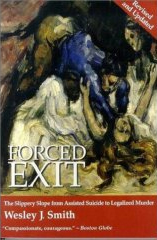 |
Forced Exit: The Slippery Slope from Assisted Suicide to Legalized MurderSmith, coauthor of Nader's recent books on insurance (1993), airline safety (1993), and "power lawyers" , makes the case against assisted suicide, challenging "right to die" advocates (whom he labels supporters of "Death Fundamentalism") and urging that "euthanasia is unwise, unethical, and just plain wrong, a social experiment that if implemented will lead to cultural and ethical catastrophe." Smith examines the philosophical and cultural roots of support for assisted suicide; outlines the Dutch experience; explores the growth of euthanasia advocacy in the U.S.; analyzes the likely place of assisted suicide within an increasingly market-driven medical marketplace, and specific groups (e.g., people with disabilities) most likely to be victimized; sketches and responds to "commonly heard arguments"; and suggests another approach--overcoming "our national death phobia," better controlling HMOs, improving hospital ethics committees, and getting communities involved in supporting ill and aging neighbors. Thoughtful and provocative. |
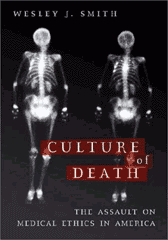 |
THE CULTURE OF DEATH THE ASSAULT ON MEDICAL ETHICS IN AMERICASmith offers a conservative perspective on medical-ethics problems such as failure to provide subjects in research programs with understandable consent forms. He fears that current utilitarian ethicists will create--some have already done so, he says--a hierarchy of human life that would basically be a descendant of Hitlerian eugenics. Doctor-assisted suicide, he believes, must inevitably lead to such a development, and he takes readers step by step on a probable path to it, inspecting each landmark court case ( Cruzan, Quinlan, et al.) along the way. He grudgingly concedes that some amelioration with controlled substances be allowed for patients suffering overwhelming pain, but he assumes that current uncontroversial pain control is more effective than many others say it is. On another major flashpoint of ethical dispute, Smith emphasizes the important benefits of research on animals. Furthermore, he makes suggestions for bringing bioethics back to what he feels is a proper philosophic and practical position, one conducive to safe and acceptable lives for both patient and doctor. |
Prescription Death: Compassionate Killers in the Medical ProfessionDr. Reed Bell, Frank York, Huntington House Publishers, 1993, ISBN 1-56384-045-6 |
|
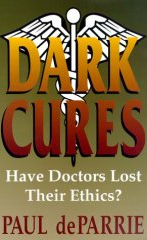 |
Dark Cures: Have Doctors Lost Their Ethics?Dark Cures exposes the vile underbelly of modern medical ethics. This world of morbid pragmatism and blatant disregard for human life is one that none of us can afford to ignore. Dark Cures provides a "survival guide" for you and your loved ones' next trip to the hospital. Paulo deParrie, Huntington House Publishers, PO Box 5378 , Lafayette , Lousisiana, 70505 |
 |
Unholy Sacrifices of the New AgeUnholy Sacrifices reveals the pagan influences behind the shift in medical and social ethics and how those changes will affect you. How do Christians take a prophetic stand? Unholy Sacrifices lays down the groundwork. |
 |
Organ Transplantation: Meanings and RealitiesThis thought-provoking book ponders the far-reaching connections of organ transplantation to human experience. A collaboration among an exceptional group of scholars and physicians, it explores matters of life and death, body and mind, psyche and soul, self and other. Sponsored by the Chicago-based Park Ridge Center for the Study of Health, Faith, and Ethics, the volume is the result of discussions among a group encompassing many religious and cultural traditions and many fields of expertise: philosophy, art, religion, folklore, psychiatry, anthropology, literature, history, social psychology, and surgery. Whether considering scientific advances in organ transplantation and their implications for medical morality, ambiguous images of organ transplantation in centuries of art and literature, and practices of organ procurement, or the complex bonds that are forged between donors, recipients, and their families, these essays carry our understanding beyond the typical scientific and pragmatic issues raised in discussions of bioethics and public policy. |
 |
By Trust BetrayedHugh Gregory Gallagher's moving study of the systematic murder of the physically and mentally disabled in the Third Reich is a riveting account that covers the subject from the larger social and historical context to the smallest details of how the killing centers functioned. It is based on extensive research, including captured Nazi documents, transcripts of testimony of the doctors and other participants in the killing program, and personal interviews. By Trust Betrayed provides new insight into the honor of ordinary people doing monstrous things under the aegis of ''science'' in Nazi Germany. It also raises troubling questions about many contemporary theories and ideas dealing with euthanasia, health care, and medical ethics. To Purchase Please call 1-800-551-7776 |
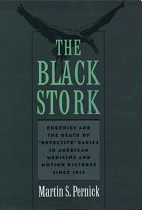 |
The Black Stork: Eugenics and the Death of "Defective" Babies in American Medicine and Motion Pictures since 1915In the late 1910s Dr. Harry J. Haiselden, a prominent Chicago surgeon, electrified the nation by allowing the deaths of at least six infants he diagnosed as "defectives". He displayed the dying infants to journalists, wrote about them for the Hearst newspapers, and starred in a feature film about his crusade. Prominent Americans from Clarence Darrow to Helen Keller rallied to his support. Martin Pernick tells this captivating story--uncovering forgotten sources and long-lost motion pictures--in order to show how efforts to improve human heredity (eugenics) became linked with mercy killing, as well as with race, class, gender and ethnicity. It documents the impact of cultural values on science along with the way scientific claims of objectivity shape modern culture. While focused on early 20th century America, The Black Stork traces these issues from antiquity to the rise of Nazism, and to the "Baby Doe", "assisted suicide" and human genome initiative debates of today. |
 |
Fatal Freedom: The Ethics and Politics of Suicide# Fatal Freedom is an eloquent defense of every individual's right to choose a voluntary death. The author, a renowned psychiatrist, believes that we can speak about suicide calmly and rationally, as he does in this book, and that we can ultimately accept suicide as part of the human condition. By maintaining statutes that determine that voluntary death is not legal, our society is forfeiting one of its basic freedoms and causing the psychiatric/medical establishment to treat individuals in a manner that is disturbingly inhumane according to Dr. Szasz. His important work asks and points to clear, intelligent answers to some of the most significant ethical questions of our time: |
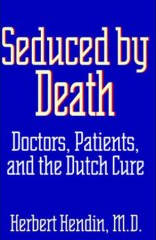 |
Seduced by Death: Doctors, Patients and the Dutch CureThe "Dutch Cure" referred to in the title of this powerful, unsettling study is, of course, euthanasia. A psychiatrist and an authority on suicide, Hebert Hendlin uses the example of the Netherlands, where physician-assisted suicide has been legal for years, to examine the current debate over euthanasia in the United States. For Hendlin, the Dutch solution creates a slippery slope toward outright killing, a term from which he does not shrink. This conclusion is supported by statistics showing that some 2,300 deaths annually in the Netherlands are ":outright euthanasia." Hendin goes on to examine prominent American legal cases, including the notorious Dr. Jack Kevorkian, and make a convincing case that the dynamics of patient-physician interaction at the close of life make reasoned, humane decisions about assisted suicide all but impossible. Hendin's book will not convince everyone, but it lays down a powerful argument for opponents to grapple with. |
 |
Death and Deliverance Euthanasia in Germany 1900-1945Between 1939 and 1945 the Nazis systematically murdered as many as 200,000 mentally ill or physically disabled people whom they stigmatised as 'life unworthy of life'. This complex and covert series of operations was known as the 'euthanasia' programme. It provided many of the personnel and the technical expertise later deployed in the 'Final Solution'. This is the first full-scale study in English of the 'euthanasia' programme. It considers the role of all those involved in these policies: bureaucrats, doctors, nurses, health officials, lawyers, clerics, and also parents, relatives, and the patients themselves. Using a wealth of original archival material, it highlights many of the moral issues involved in a way that is profoundly disquieting. The book concludes by showing the ease with which many of the perpetrators filtered back into German society after 1945. --This text refers to an out of print or unavailable edition of this title. |
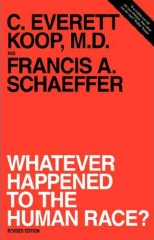 |
Whatever Happened to the Human Race?Dr. Francis Schaeffer and former U.S. Surgeon General Dr. C. Everett Koop speak out on issues such as abortion, infanticide, and euthanasia. Confronting the 'culture of death' mentality of this century, both authors provide a frightening look at society if it does not change the direction it is travelling, making this century one of the bloodiest in human history. The authors address the wonder and beauty of human life, from the developing unborn child, to the disabled, both newly born, child and adult. |
Journey with JayDo miracles still occur today? Jan Peine, a rehabilitation specialist was skeptical until she was asked to work with Jay Basselin, an extraordinary Christian man who was recovering from a catastrophic brain injury. Jay's uncanny survival, which could be deemed miraculous, left him with a rare amnesia, which deprived him of recognizing everyday food items, and even his own reflection in the mirror. Jan's challenge was to teach this gentle giant, who was now limited in mental function and void of all memories, how to function in today's world. She did not realize that in the end he would teach her more! Jay's colorful antics, which are delightfully innocent, should amuse the most somber reader, while his unsettling, inquisitive questions regarding our society evoke soul-searching answers. This is the intriguing, true story of Jay Basselin's recovery---an inspirational must for anyone who doubts the healing power of faith. |
|
 |
Brain Death and Disorders of ConsciousnessAlthough some decades have passed, there are still worldwide controversies about a concept of human death on neurological grounds. There are also disagreements on the diagnostic criteria for brain death, whether clinical alone or clinical plus ancillary tests. Moreover, some scholars who were strong defenders of a brain-based standard of death are now favoring a circulatory-respiratory standard. The study of coma is extremely important because lesions of the brain are responsible for quality of life in patients or cause of death. The main goal of Brain Death and Disorders of Consciousness is to provide a suitable scientific platform to discuss all topics related to human death and coma. |
Back To Top



